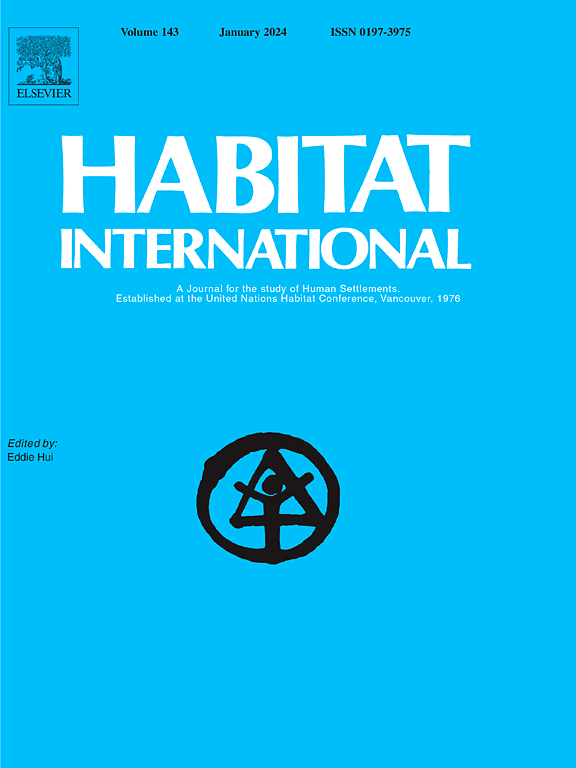Urban regeneration strategy for shrinking neighborhoods: A case study of Gyo-Byu water pipeline, Yangon
IF 6.5
1区 经济学
Q1 DEVELOPMENT STUDIES
引用次数: 0
Abstract
In recent years, linear infrastructure has become a critical element in shaping urban neighborhoods, particularly in developing countries where neighborhoods near such infrastructure often face significant challenges, such as urban shrinkage. In Yangon, the presence of colonial-era linear infrastructure, such as the Gyo-Byu water pipeline, plays a vital role in the city's core development and contributes to the identity of the urban fabric. This study investigates the urban vulnerability faced by neighborhoods along the Gyo-Byu water pipeline, analyzing the context of shrinking neighborhoods and exploring key challenges that neighbors encounter. It employs a phenomenological approach, grounded in multi-qualitative neighborhood assessment methods, including field observation, on-the-spot interviews, focus group discussion, institutional data analysis, and spatial neighborhood mapping. Interview data was analyzed using reflexive thematic method by MAXQDA software. The study focuses on three core aspects: the relationship between linear infrastructure and neighborhood dynamics, key neighborhood problems, and local priorities and aspirations of neighborhood regeneration needs. Findings highlight that neighborhood social fragmentation and livability challenges, multidimensional barriers to business viability, neighborhood environmental degradation and lack of green infrastructure present major challenges for surrounding neighborhoods of Gyo-Byu water pipeline. Furthermore, the research found that Gyo-Byu water pipeline as neighborhood identity and dual-role linear infrastructure assets. In response, the research proposes three-approaches strategies to urban acupuncture regeneration framework that emphasizes infrastructure improvement, community development, and sustainability. This research provides valuable tools for policymakers and urban stakeholders, offering targeted strategies for revitalizing shrinking urban neighborhoods through sustainable infrastructure and community development.

萎缩社区的城市再生策略:以仰光Gyo-Byu输水管道为例
近年来,线性基础设施已成为塑造城市社区的关键因素,特别是在发展中国家,这些基础设施附近的社区往往面临着城市萎缩等重大挑战。在仰光,殖民时期的线性基础设施的存在,如Gyo-Byu输水管道,在城市的核心发展中起着至关重要的作用,并有助于城市结构的身份。本研究调查了Gyo-Byu输水管道沿线社区所面临的城市脆弱性,分析了社区萎缩的背景,并探讨了社区面临的主要挑战。它采用现象学方法,以多质社区评估方法为基础,包括实地观察、现场访谈、焦点小组讨论、机构数据分析和空间社区制图。访谈数据采用自反主题法,采用MAXQDA软件进行分析。本研究集中在三个核心方面:线性基础设施与社区动态之间的关系、关键社区问题、当地优先事项和社区再生需求的愿望。研究结果表明,社区社会碎片化和宜居性挑战、商业可行性的多维障碍、社区环境退化和缺乏绿色基础设施是桥碧输水管道周边社区面临的主要挑战。此外,研究发现桥边输水管道作为社区身份和双重角色线性基础设施资产。为此,本研究提出了以基础设施改善、社区发展和可持续性为重点的城市针刺再生框架的三条路径策略。本研究为政策制定者和城市利益相关者提供了有价值的工具,为通过可持续基础设施和社区发展振兴萎缩的城市社区提供了有针对性的策略。
本文章由计算机程序翻译,如有差异,请以英文原文为准。
求助全文
约1分钟内获得全文
求助全文
来源期刊

Habitat International
Multiple-
CiteScore
10.50
自引率
10.30%
发文量
151
审稿时长
38 days
期刊介绍:
Habitat International is dedicated to the study of urban and rural human settlements: their planning, design, production and management. Its main focus is on urbanisation in its broadest sense in the developing world. However, increasingly the interrelationships and linkages between cities and towns in the developing and developed worlds are becoming apparent and solutions to the problems that result are urgently required. The economic, social, technological and political systems of the world are intertwined and changes in one region almost always affect other regions.
 求助内容:
求助内容: 应助结果提醒方式:
应助结果提醒方式:


